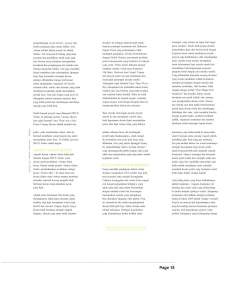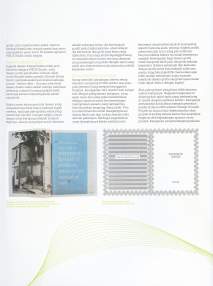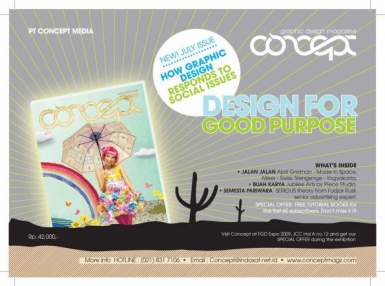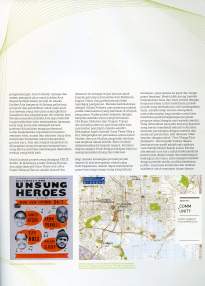Concept Magazine: Jakarta PIECE Studio Interview 2010
About this project
PIECE Studio was interviewed by CONCEPT Design Magazine located in Jakarta, Indonesia about our work, mission and values. They asked us to talk about the importance of PIECE Studio social justice projects and specifically we showcased the East Baltimore Community Leaders ‘UNSUNG HEROES’ intervention poster, the ‘ONCE THERE WAS A BOY’ Arabic/English illustrated poem, the ‘BREJTP COMMUNITY GUIDE’, the ‘MARTHA’S PLACE: A PLACE FOR CHANGE’ photo novella, and the JUBILEE ART CENTER identity and environmental signage project.
The focus of this issue of CONCEPT magazine was to celebrate design for social change and the magazine also contained interviews by Ken Garland, April Greiman and Rick Poyner as well as an article on Tibor Kalman.
INTERVIEW
1. Piece Studio is a socially based collaborative design studio in search of creating positive change. What positive change you are talking about?
We believe that PIECE Studio gives a voice to people who cannot speak for themselves. We want to assist the marginalized, the disenfranchised and those who are outside of what society sees, wants to see or wants to help. We work with individuals, communities, community organizations, government organizations and academic institutions.
PIECE Studio achieves positive change by addressing social, educational, economical and racial inequality. We feel that both local and national governments have failed to address the injustice between poverty and equality or they have shamelessly turned their backs on the poor and to only service the needs of the rich and powerful. We feel design has the responsibility and power to bring positive change-it is up to design to make a difference and to bring environmental justice. PIECE Studio projects are involved at the micro and macro levels. We produce projects that are a direct response from working with a partner and sometimes we produce ‘design interventions’ that are a direct response from what we feel needs to be highlighted.
An example of a partnership project was a project that we are working on at the current time called Jubilee Arts. We are developing an identity, environmental signage and a way finding system for an inner-city art center called Jubilee Arts. Jubilee Arts is a part of Newborn Holistic Ministries and they are located in West Baltimore, Maryland USA. PIECE Studio had produced a project for Martha’s Place, which is also part of Newborn Holistic Ministries, called a ‘Place for Change’ several years ago and we have been friends with them ever since. Martha’s Place provides respite and counseling for women who are dealing with chemical and alcohol addiction. Jubilee Arts will provide programming and education for children and adults and raise awareness and self esteem through art.
West Baltimore is a violent and neglected place, but there are so many fantastic people there who are trying to make a positive impact on their community. These are the real heroes and PIECE STUDIO is proud to assist them in any way we can.
An example of a Piece Studio intervention is the ‘Unsung Heroes’ poster and the ‘Once There Was a Boy’ illustrative poem. An intervention happens when we see that is not an issue being addressed by anyone. The Unsung Heroes poster was a direct response for PIECE Studio to pay homage to the many community leaders from East Baltimore whose work is never credited. We collaborated with Globe Printers who are located in the same area of Baltimore and who have an international reputation for producing music posters. They have a fantastic visual aesthetic that we felt that it represented the community leaders. We selected a few community leaders who we had worked with in the past and placed their names and photographs on the poster. The typography, image style and word choices were reminiscent of the old Blues, Motown and Gospel posters that Globe produced. The posters were placed in East Baltimore for the community to celebrate their leaders. We wanted everyone to know that we recognized and lauded him or her as the true heroes. We placed the posters up late at night throughout the community and the posters greeted everyone the next morning. Our work is always about raising awareness and self esteem. It’s also about celebrating community pride.
The Once There Was a Boy illustrated poem was about expressing the divide between Muslim and Non–Muslims. We had worked on a project in Dubai and wanted to reach out to children and try and express that we understood that people feel helpless when they are caught up in conflict. PIECE Studio wanted to create a dialogue of mutual respect. The book is in both English (reading left to right) and Arabic (reading right to left) when you turn the book over. The book has been circulated in throughout many countries and the hope is that this will promote conversation and tolerance.
2. As graphic designers, what could we do due to transform the society?
Designers and artists have an obligation to engage society. The UN Millennium Report stated that if current world socioeconomic trends continue then their will be an smaller and much richer world super consumer class, a vastly smaller and almost nonexistent world middle class and a vastly increased and poorer world poverty class. It makes sense to us that if design does not play a part in changing this worldview then there will be no jobs for designers. This is because the design needs people with money to purchase the things we produce. If the world middleclass disappears and the world super rich gets smaller and richer then there will be fewer people for us to connect with. Design is educating and promoting its way into extinction.
Designers have to intervene, create new markets, help the underserved to create a voice for them to create products and market themselves. We must address this inequality-we are morally bound to do so, and it just makes good business sense as well. We feel the Jubilee Art project is a good example of how design can create new markets for the disenfranchised. We produced the Place of Change photo novella that told the story about Martha’s Place, the history of West Baltimore and then asked people to financially support Martha’s Place. One could argue that this publication assisted in the funding to create Jubilee Arts. Jubilee will create more jobs in the community to run the organization, and, in time, local artists, musicians and designers will create new markets and products. The fabric of West Baltimore will change for the better. There are a million stories to be told that are similar to Martha’s Place and a million opportunities to crate new markets-it only takes one designer to walk into a community, start a conversation and make a difference.
3. How important is it for a designer, especially a graphic designer to care about social conscience?
We do not think that it’s only the designer who should care about social involvement– it’s everyone’s responsibility. It’s a moral imperative and we each have a choice.
We can deny the injustice or walk away from the prejudice or turn our back on the suffering. But sooner or later, in one form or another, we will be confronted by it, and it will be quick and it will be nasty, and then it will be too late.
4. How do you stick to what you believe in as socially based designers when other designers might say that you are not adding to the economy?
It’s an easy choice for us to make because we feel that there IS ONLY social design. PIECE Studio works with large corporations and academic institutions and other partners who pay for the work that we do. Then we funnel some of the funding into the projects that there isn’t a funding stream for. PIECE Studio is not a normal design studio. We do not act as a service provider, which means that we are not interested in working with clients who ask us to develop a letterhead, business card, website etc. We are interested in clients who come to us and ask, “Help us understand who we are and what we do.” PIECE Studio is also different in that we organize teams around projects. We are an organic organization. For example we recently traveled to Hale County, Alabama to work with Pam Dorr of HERO (Hale Empowerment and Resource Organization), and we took a group comprising of graphic and web designers, a writer from Metropolis Magazine, and a photographer. For the Jubilee and Sight Projects we teamed with two individual designers.
We feel many designers are still thinking in terms of design for non-profits as the only way to produce social design. It’s as if they are thinking only in terms of the “First Things First Manifesto.’ There is a new way to concentrate fully on social design and make a living from it. It’s about connecting with medical researchers, public health practitioners, community organizations and academic institutions. It’s working with grant writers and creating new markets. This is where PIECE Studio is making its mark.
5. In your opinion, how could we achieve sustainability design in terms of graphic design?
Sustainability is such a vague and overused word, and it can be difficult to address. Sustainability can relate to idea of designers using less paper or more recycled substrates and focus on web and interaction as the delivery vehicles. Using the web interface, as the primary delivery vehicle for many of PIECE Studio’s projects can be problematic, as many of the communities that we work in do not have computers-they simply cannot afford them.
Sustainability can relate to design as a discipline and we see this as the biggest hurdle that design and design education have to come to grips with. I feel that many academic institutions focus on an antiquated delivery system comprising of a series of classes that focus on delivering specific skill sets. For example classes that are called Typography One followed by Typography Two and a series of consecutive classes named Graphic Design One, Two, Three etc. Design education needs to be delivered in terms of realistic projects that create new products and new markets. Classes need to have students from different majors develop multidisciplinary teams around these projects. Students will take skills when they need them and as they apply to the project. Students will teach students skills from their own majors and students will learn faster and will learn more. These students will understand the importance of the team dynamic. See the world and projects in terms of ‘theirs’ rather than ‘mine’ and will be further ahead than students who have gone through a regular design program. The new student would have interfaced with and had experience of business models, public health ideas, government policy procedures, product design, funding and grant writing. The new student should be a big picture problem solver and less of a small picture service provider. The world’s market forces are changing at a rapid pace and situations can occur almost overnight. Designers have to be able to respond to a shifting workplace and be at ease working in London, Beijing, Paris and New Delhi. We believe PIECE Studio’s model represents this approach to big picture thinking because we are involved in design projects for clients such as GOOD Magazine and The Good Sheet: Starbucks, but we are also working with medical researchers to sustain public health problems, architects to address urban planning issues, and schools to develop educational models.
And sustainability can also mean the interrelationship between designer and community, and country to country. We need each other and we have to help each other. We have traveled throughout Asia and we feel something very interesting and exciting is happening there. The West has driven design and now we could be witnessing a shift to Asia leading the way. We feel that the West might be too set in its ways and too top heavy. One could argue that the West might also be too arrogant and resistant to change. Innovation is going to come from the emerging economy, it will happen in the margins and it will be exciting, and new. Designers and Design Educators and students have get involved and make the world a better place for everyone. It begins with design education and it’s about taking the academie out to the community.
6. How do you come up with your ideas and is the process different from other studios?
The creative process for PIECE Studio is reflective of an organic structure. We feel that everybody has a voice at the table and all ideas are great ideas. This means that we involve the client, the community, community leaders and every member of the PIECE team. The communities that we are servicing inform many of the PIECE Studio creative solutions. It becomes all about obtaining community ownership of our designs and our role is to listen and then reflect. PIECE Studio embraces a lateral management and creative structure. Student interns have as much creative input as everyone-it’s quite liberating at refreshing. The one thing that makes PIECE Studio an exciting place to work is because of the projects we select and listening to the needs and wishes of the community. We are open to all ideas and so the design process becomes exhilarating because we are all focusing on helping the community and less about stroking our own egos.
7. What is the concept for the Jubilee Arts project?
The Jubilee Arts identifier represents the shape of the building and it also represents the community of West Baltimore. The West Baltimore houses are made of red bricks and are joined together. The buildings are tall and narrow and the streets run parallel to each other. There is a great deal of community strength and spirit and everyone is interconnected. The focus was to create a strong and vibrant identifier that responded to the needs of the community and reflected what we saw in the community. We created a segmented “J” that can be filled with solid colors and images. The “J” is constructed from two shapes–a square and an arched triangle. Ben had the idea to create a complete alphabet for the client-something they would own and speak about community pride. So Jubilee Arts has their own font where each letterform is constructed from these two shapes. These shapes decorate the floors and walls of the building. There are three floors to Jubilee Arts. The first floor will give dance lessons, hold art exhibitions and hold community events. The shapes on this floor playfully dance around the floors and walls. The second floor contains the art classes. Here the shapes playfully create shapes on the walls and floors. The third floor contains the counselors and therapists for Martha’s Place. The shapes on this floor are much more subdued, nurturing and contained. We are having a large ‘J’ constructed from tubular lights that will be placed on the exterior of the building. We want the light to shine on the community and for the community to see that Jubilee Arts as at the heart of the community. We feel that we have come up with a very versatile symbol and system and the initial idea came from the community explaining their building shapes and streets.
8. Tell us about the process-what happens in between ideation, to final solutions, and what technology, methods, tools, and materials do you apply?
The initial creative phase consists of paper, pencils, markers and pens. We sometimes use dry erase boards and LCD Projectors or computer screens to show photographs and video. We take a great deal of photographs at the start of the project. We take photographs of buildings, structures, peoples-we shoot EVERYTHING. We interview people and take their photograph again. The initial phase is very playful and we bounce ideas around and off each other. We then switch to the computer and use the same design programs as everyone else. Although on some projects we have used cut stencils and spray paint as the final delivery vehicle.
Once we have selected some idea directions that we feel are reflective of the community and client needs we present these to the client and community in the at a community focus group. If we are showing a playful pictographic symbol then we initially educate everyone what a playful pictographic symbol looks like. We show examples of effective symbols and we use words that describe the emotive content of what the audience is looking at. Once we feel confident that the audience understands what we are talking about we show them what we have designed. It’s easier having a visually literate audience and we have a great deal of fun with our presentations.
This second phase can be very loud with a great deal of energy. We take a great deal of notes, take even more photographs and record what people are saying. Then we go back to the studio and have another creative session and reflect what people said. Then there is another focus group and we ask everyone what do you think and then, if we have done our job right and listened then we have a sexy final product that the community and client love.
9. Tell us about your struggles to complete these projects?
The struggle for us is always knowing when to leave a project go-to say it is ready-it is finished. We deal with communities who have been neglected for the longest time and we do not want to let them down. We are working on a lot of projects for PIECE Studio as well as our own personal projects and there is a great deal of long nights. We select designers, writers, filmmakers, and illustrators etc. that have the same ideas as we do and are fun to be around. We are certainly interested in people who can roll their sleeves up and work with a team. We also work with people who put community needs above their own.
10. What are the values of and benefits of this project?
Bottom line-the community and client owns the process and final project. Jubilee Arts will provide employment for people in the community and act as a creative safe haven for children, teenagers and adults. Community jobs will be created and community artists will come forward who will sell their creations. The fabric of the community will improve and we, at PIECE Studio, will be the better for it and sleep contently at night.
I still have one more question for you-hope you don’t mind to answering it.
11. What do you think of the First Things First Manifesto-could you please explain?
I believe the “First Things First Manifesto” was an interesting attempt for designers to legitimize what they did for a living. I believe that it allowed designers to have an easy option and say, “Hey, we can do good work for good causes and help poor people.” Then they could spend the rest of their time making things that people do not really need. Whether it is the initial UK manifesto or the second US/UK revisit it’s the same myopic view that it supports. I feel there is a new and better alternative to the manifesto. Designers can concentrate on social design and make a living from it and make the world a better place to be. It’s about giving and not taking and it’s about engaging communities and working with diverse multidisciplinary teams. I want to live in a world where designers are sitting at the table and helping to solve the major issues that confront the world today. We can change behavior and we can make a difference-it’s only a matter of if we choose to do so.











